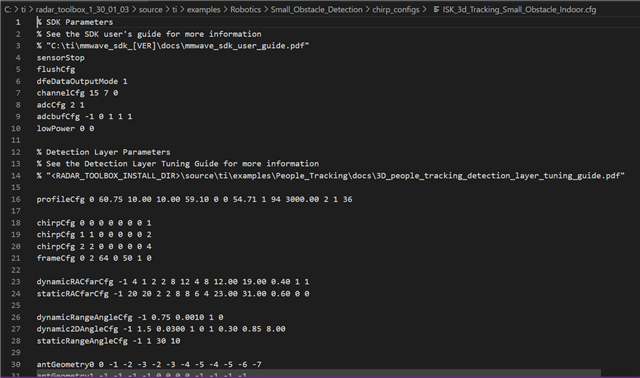I am trying to use my iWR6843ISK board to run the small obstacle detection lab. The goal is to get the output data when an object is detected in the occupancy box and use the signal to control another device connected to the same PC through USB.
I first tried to run the example lab in the Robotics library, I burnt the prebuilt_binaries .bin code under mmwave_industrial_toolbox/labs/Robotics/Small_Obstacle_Detection into the iWR6843ISK board, then used the configuration file under Small_Obstacle_Detection/Chirp_configs to see how the board works in visualizer, everything worked very well, I could see the two zones showing in the visualizer window and turned red from green when objects are placed in front of the board, everything works fine. Then, I tried to follow the Small Obstacle Detection User's Guide to modify the source for the demo and visualizer, that's when I encounter problems. I first import and build the project in CCS, it went well, both the DSS and MSS projects were built in the workspace directory. I also successfully burnt the .bin code generated in the MSS project directory to the board, but when I tried to use visualizer to see how the board works, I run into problems, first I don't know which configuration file should I use, I tried to use the same configuration file in the Small_Obstacle_Detection/Chirp_configs directory as I used when I run the demo, but it didn't work, I got this Index out of range error on the terminal window:
Traceback (most recent call last):
File "gui_threads.py", line 40, in run
outputDict = self.parser.readAndParseUart()
File "gui_parser.py", line 74, in readAndParseUart
if (magicByte[0] == magicWord[index]):
IndexError: index out of range
Traceback (most recent call last):
then I tried to use the .cfg files under the newly built project directory in workspace, there is one file called mmw_mss.cfg under workspace/small_obstacle_detection_68xx_mss, and also a file called mmw_mss_per4ft.cfg under workspace/small_obstacle_detection_68xx_mss/Debug/configPkg/package/cfg, I tried to use both cfg file in visualizer, but both didn't work, it's showing "No cfg file selected!" in the terminal window.
Could you help me to move forward? Thanks a lot!



